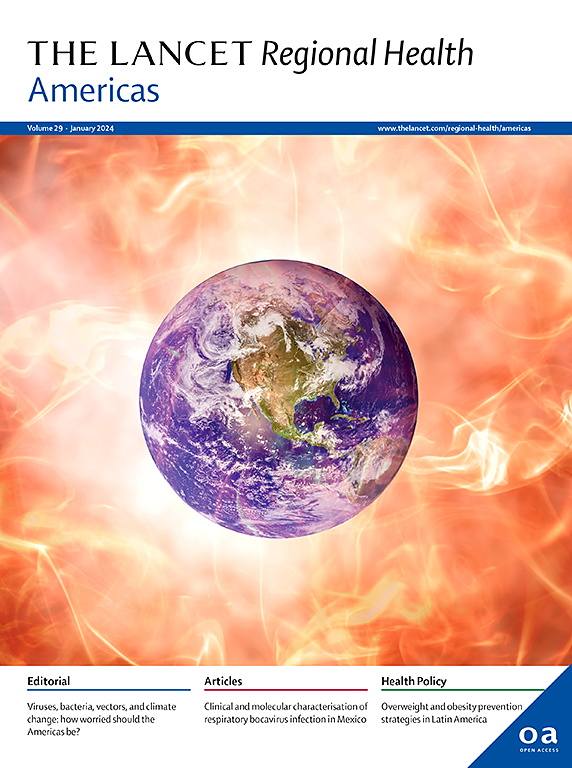巴西土著育龄妇女的死亡率趋势:时间序列分析
IF 7
Q1 HEALTH CARE SCIENCES & SERVICES
引用次数: 0
摘要
背景:关于巴西土著人民的报告强调了死亡率的差异,但对死亡的病因知之甚少,特别是在育龄妇女中,或基于种族/肤色的结构性歧视如何影响该群体的死亡率。本研究旨在评估和比较巴西土著和白人育龄妇女之间的死因特异性死亡率,确定健康差异,为有针对性的公共卫生干预提供信息。方法本生态研究使用巴西死亡率信息系统(SIM)的死亡率数据。人口估计是根据人口普查预测得出的。我们计算了2010年至2019年期间全国各地土著和白人群体中死亡的育龄妇女(10-49岁)的年年龄标准化死亡率(ASMR)。死因按ICD-10分类。趋势估计使用Prais-Winsten回归,表示为年百分比变化。我们分析了3185名土著妇女和274393名白人妇女的死亡情况。土著妇女的ASMR没有因任何ICD-10原因而下降。与白人女性不同,原住民女性的ASMR因消化(+ 12.36%)、循环(+ 8.88%)和呼吸(+ 4.56%)原因而上升。由于肿瘤和内分泌、代谢和营养疾病,这两个群体的ASMR都有所上升,土著妇女的增幅更高。产妇死亡率在两组中保持稳定,但程度不同。外因和感染/寄生虫引起的ASMR在土著妇女中保持稳定,但在白人妇女中下降。主要由慢性循环系统、消化系统和呼吸系统疾病引起的死亡率正在上升,而感染性/寄生性、母性或外因的死亡率却没有下降。对慢性疾病死亡人数上升的进一步调查可能揭示导致早期死亡的不公平现象。确定土著保健政策中的差距,可指导更有效地针对土著人民的需要采取干预措施。本研究由本文章由计算机程序翻译,如有差异,请以英文原文为准。
Mortality trends among Indigenous women of reproductive age in Brazil: a time series analysis
Background
Reports on Brazilian Indigenous peoples highlight mortality disparities, yet little is known about death aetiology—particularly among women of reproductive age—or how structural discrimination based on race/skin colour influences mortality rates in this group. This study aimed to assess and compare cause-specific mortality rates between Indigenous and White Brazilian women of reproductive age, identifying health disparities to inform targeted public health interventions.
Methods
This ecological study used mortality data from Brazil's Mortality Information System (SIM). Population estimates were based on census projections. We calculated annual age-standardized mortality rates (ASMR) for women of reproductive age (10–49 years) from Indigenous and White groups who died between 2010 and 2019 all over the country. Causes of death were classified by ICD-10. Trends were estimated using Prais-Winsten regression, expressed as annual percentage change.
Findings
We analysed 3185 deaths among Indigenous women and 274,393 among White women. ASMR among Indigenous women did not decline for any ICD-10 cause. Unlike White women, Indigenous women exhibited rising ASMR for digestive (+12·36%), circulatory (+8·88%), and respiratory (+4·56%) causes. Both groups experienced rising ASMR due to neoplasms and endocrine, metabolic, and nutritional diseases, with higher increases among Indigenous women. Maternal deaths remained stable in both groups but at different magnitudes. ASMR from external and infectious/parasitic causes remained stable among Indigenous women but declined among White women.
Interpretation
Mortality from predominantly chronic circulatory, digestive and respiratory diseases is increasing without a decline in infectious/parasitic, maternal, or external causes. Further investigation into rising chronic disease deaths could reveal inequities driving early mortality. Identifying gaps in Indigenous health policies may guide more effective interventions tailored to Indigenous people needs.
Funding
This study was funded by Coordenação de Aperfeiçoamento de Pessoal de Nível Superior (CAPES), Ministério da Educação, and Pró-Reitoria de Pesquisa, Universidade Federal de Minas Gerais.
求助全文
通过发布文献求助,成功后即可免费获取论文全文。
去求助
来源期刊

Lancet Regional Health-Americas
Multiple-
CiteScore
8.00
自引率
0.00%
发文量
0
期刊介绍:
The Lancet Regional Health – Americas, an open-access journal, contributes to The Lancet's global initiative by focusing on health-care quality and access in the Americas. It aims to advance clinical practice and health policy in the region, promoting better health outcomes. The journal publishes high-quality original research advocating change or shedding light on clinical practice and health policy. It welcomes submissions on various regional health topics, including infectious diseases, non-communicable diseases, child and adolescent health, maternal and reproductive health, emergency care, health policy, and health equity.
 求助内容:
求助内容: 应助结果提醒方式:
应助结果提醒方式:


